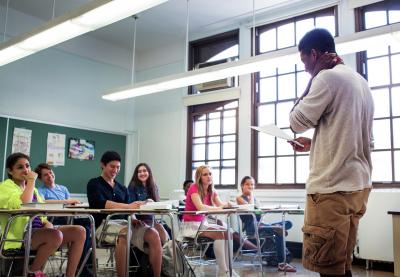Editor’s note: This post is part six of a series on teaching and learning how to know in 2017. Find part one, a discussion of key terms from cognitive science and media literacy, here. Find part two, a classroom example of teaching about confirmation bias, here. Find part three, a window into a classroom discussion on trust and knowledge, here. Find part four, a review of how students learn how to know (epistemological development) here. Find part five, a discussion of skepticism and bias, here.
Concerns about teachers “brainwashing” students are as old as the teaching profession itself, but they reach a fever pitch in moments of extreme political polarization. This is due in part to the strong connection between a polarized public and distrust—of fellow citizens, of the media and of institutions like school. It’s harder to teach students how to know now because polarization has made it more difficult to agree on a set of facts, priorities and strategies while also raising the stakes and scrutiny of what happens in classrooms.
Teaching students about ideology and ideological diversity is one strategy for cutting through this tension. Although many educators are skillfully teaching about socioeconomic, racial, ethnic and religious diversity, teaching about the variety of viewpoints, perspectives and ideologies present within a community doesn’t get the same attention.
Viewpoint diversity is important because teaching in what Paula McAvoy and Diana E. Hess refer to as “like-minded schools” is increasingly common—and may only become more so. Classrooms and schools can be echo chambers in much the same way as other communities and social media channels. Teaching diverse ideologies or viewpoints doesn’t mean always presenting two sides of every issue or presenting ideas without criticism, however. It’s important for teachers to not fall into false equivalences when there is no legitimate disagreement.
Teaching about various viewpoints means assessing the perspectives that might already be represented in your classroom. During the 2016 presidential campaign, many teachers did this by having students take quizzes available online to assess their political stances. It is similarly important for teachers to scrutinize their curricula and lessons for viewpoint uniformity. This post by school librarian Tasha Bergson-Michelson highlights how she tackled her media blind spots and biases.
Once teachers identify these aspects, they can take steps to bring in additional perspectives or ideologies, provided they meet classroom standards and are shared with students in developmentally appropriate ways. It’s vital that teachers make this process transparent and open to students.
Lessons like this one from The Choices Program (and their whole approach) and this one from The New York Times’ Learning Network encourage students to wade into complex issues with an eye toward enhancing their thinking, questioning existing assumptions and understanding others’ perspectives. News sources like All Sides or ProCon, which aim to present diverse viewpoints, are two other resources.
There is even compelling new research supporting the idea that teachers can boost critical thinking by having students imagine a dialogue between supporting and opposing sides of an argument. (There are clear limits to this type of exercise; students should never, for example, be asked to defend atrocities such as slavery and genocide or engage in activities that disparage or demean identity groups.)
For students, learning within an environment that reflects diverse viewpoints is as much about understanding others’ perspectives as it is about understanding their own. It involves interrogating assumptions, ideas and biases, as well as gaining familiarity with opposing and supporting views on an issue. It doesn’t mean blindly accepting everything as true or collapsing ideas into weak-kneed relativism. But it does mean broadening their knowledge landscape, ultimately learning how they know and what they believe in.
Mainstreaming of Hate
If polarization makes it difficult to teach about diverse perspectives, the challenge is only increasing due to the mainstreaming of hateful ideologies. For example, rising Islamophobia means educators have a heightened responsibility when working to counter it and when teaching about Islam. Similarly, the prevalence of climate change denial, in spite of scientific consensus about its imminence and effects, changes the way we have to teach about it.
In the classroom, teachers cannot simply rely on a model of presenting supporting and opposing views on issues. The views of Islamophobes, for example, do not deserve equal consideration, but on issues on which there is legitimate or high-profile disagreement, teachers have a responsibility to present and unpack a variety of viewpoints. Determining that line is perhaps the most challenging part of teaching in today’s political climate. For example, even though we wouldn’t want to promote a false equivalence between climate change denial and climate change acceptance, we also can’t pretend that denial doesn’t exist.
Just as the content we choose can promote diverse perspectives and key values, so can the skills we seek to foster in students. So, when students in a Boston high school classroom were introduced to the ideas of the “alt-right,” they brought to their learning a well-honed toolkit of critical literacy skills and the values of inclusivity and tolerance. Their teachers could trust that the students would see this movement for what it is. The planned setting of a scaffolded curriculum is exactly the right place to learn how to separate viable, inclusive ideology from bigotry, conspiracy theories and paranoia.
It’s a challenging time to be a teacher. Yet, if we really want students to think and know well, we have to help them cultivate the values of empathy, humanism and inclusivity. That means helping them consider the broadest possible set of viable ideas and helping them develop the tools to construct their belief systems. They need our guidance to craft the skills to identify how various viewpoints and ideologies are shaping the world around them.
Gold is a seventh- and eighth-grade history teacher at Moses Brown School in Providence, Rhode Island. You can reach him on Twitter @jonathansgold.


0 COMMENTS